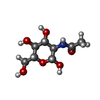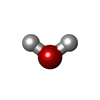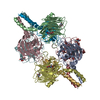+Search query
-Structure paper
| Title | The structural organisation of pentraxin-3 and its interactions with heavy chains of inter-α-inhibitor regulate crosslinking of the hyaluronan matrix. |
|---|---|
| Journal, issue, pages | Matrix Biol, Vol. 136, Page 52-68, Year 2025 |
| Publish date | Jan 13, 2025 |
 Authors Authors | Anokhi Shah / Xiaoli Zhang / Matthew Snee / Michael P Lockhart-Cairns / Colin W Levy / Thomas A Jowitt / Holly L Birchenough / Louisa Dean / Richard Collins / Rebecca J Dodd / Abigail R E Roberts / Jan J Enghild / Alberto Mantovani / Juan Fontana / Clair Baldock / Antonio Inforzato / Ralf P Richter / Anthony J Day /    |
| PubMed Abstract | Pentraxin-3 (PTX3) is an octameric protein, comprised of eight identical protomers, that has diverse functions in reproductive biology, innate immunity and cancer. PTX3 interacts with the large ...Pentraxin-3 (PTX3) is an octameric protein, comprised of eight identical protomers, that has diverse functions in reproductive biology, innate immunity and cancer. PTX3 interacts with the large polysaccharide hyaluronan (HA) to which heavy chains (HCs) of the inter-α-inhibitor (IαI) family of proteoglycans are covalently attached, playing a key role in the (non-covalent) crosslinking of HC•HA complexes. These interactions stabilise the cumulus matrix, essential for ovulation and fertilisation in mammals, and are also implicated in the formation of pathogenic matrices in the context of viral lung infections. To better understand the physiological and pathological roles of PTX3 we have analysed how its quaternary structure underpins HA crosslinking via its interactions with HCs. A combination of X-ray crystallography, cryo-electron microscopy (cryo-EM) and AlphaFold predictive modelling revealed that the C-terminal pentraxin domains of the PTX3 octamer are arranged in a central cube, with two long extensions on either side, each formed from four protomers assembled into tetrameric coiled-coil regions, essentially as described by (Noone et al., 2022; doi:10.1073/pnas.2208144119). From crystallography and cryo-EM data, we identified a network of inter-protomer salt bridges that facilitate the assembly of the octamer. Small angle X-ray scattering (SAXS) validated our model for the octameric protein, including the analysis of two PTX3 constructs: a tetrameric 'Half-PTX3' and a construct missing the 24 N-terminal residues (Δ1-24_PTX3). SAXS determined a length of ∼520 Å for PTX3 and, combined with 3D variability analysis of cryo-EM data, defined the flexibility of the N-terminal extensions. Biophysical analyses revealed that the prototypical heavy chain HC1 does not interact with PTX3 at pH 7.4, consistent with our previous studies showing that, at this pH, PTX3 only associates with HC•HA complexes if they are formed in its presence. However, PTX3 binds to HC1 at acidic pH, and can also be incorporated into pre-formed HC•HA complexes under these conditions. This provides a novel mechanism for the regulation of PTX3-mediated HA crosslinking (e.g., during inflammation), likely mediated by a pH-dependent conformational change in HC1. The PTX3 octamer was found to associate simultaneously with up to eight HC1 molecules and, thus, has the potential to form a major crosslinking node within HC•HA matrices, i.e., where the physical and biochemical properties of resulting matrices could be tuned by the HC/PTX3 composition. |
 External links External links |  Matrix Biol / Matrix Biol /  PubMed:39814214 PubMed:39814214 |
| Methods | EM (single particle) |
| Resolution | 3.33 Å |
| Structure data | EMDB-19717, PDB-8s50: |
| Chemicals |  ChemComp-NAG:  ChemComp-HOH: |
| Source |
|
 Keywords Keywords | IMMUNE SYSTEM / PTX3 / Pentraxin / pattern / recognition / coiled-coil / coil / innate / immunity / extracellular / octamer / Pentraxin-related / cryo-EM |
 Movie
Movie Controller
Controller Structure viewers
Structure viewers About Yorodumi Papers
About Yorodumi Papers





 homo sapiens (human)
homo sapiens (human)